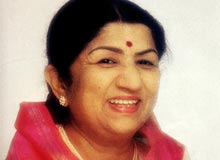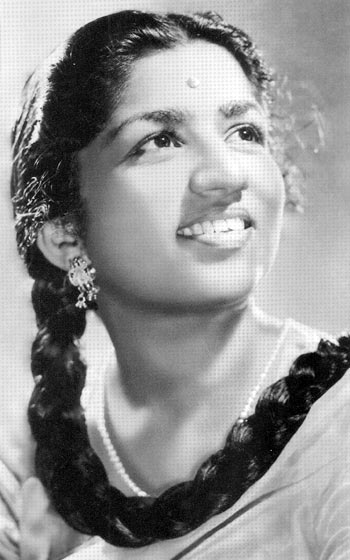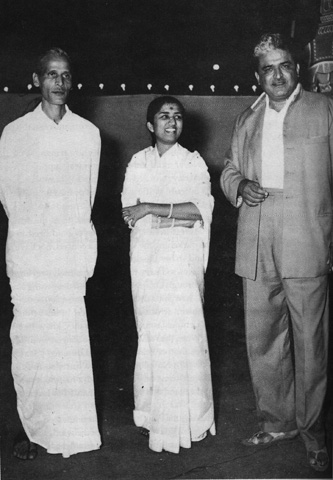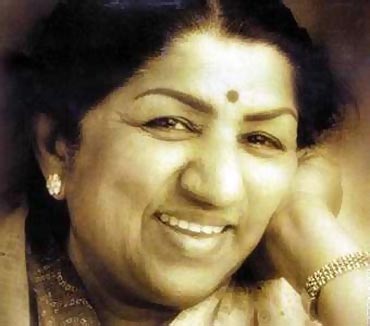
Name:- Lata Mangeshkar
Other Name:- Didi, Nightingale of India.
Indore, Central India Agency, British India
Marital Status:- Unmarried
Zodiac Sign:- Libra
Occupation:- Playback singer
Father Name:- Deenanath Mangeshkar
Mother Name:- Shevanti Mangeshkar
Relatives:- Hridaynath Mangeshkar (Brother).
Asha Bhosle (Sister).
Usha Mangeshkar (Sister).
Meena Mangeshkar (Sister).
Awards:-Padma Bhushan 1969,
Guinness Book of World Records 1984,
Dada Saheb Phalke Award 1989,
Maharashtra Bhushan Award 1997,
NTR National Award 1999,
Padma Vibhushan 1999,
Bharat Ratna 2001,
National Film Awards (3), (1972, 1974 and 1990).
Filmfare Awards in 1959, 1963, 1966 and 1970.
**********************************************************************************************************************************************************************************************************************************************************************************************
Filmfare Awards in 1959, 1963, 1966 and 1970.
Biography:-


Lata Mangeshkar was born in the princely state of Indore, which is now a part of present state of Madhya Pradesh. Her father, Deenanath Mangeshkar was a classical singer and theatre artist. Lata is the oldest of all her siblings. Her music career started as early as the age of five, when she started assisting her father, in his musical plays. Her father passed away when she was merely 13 and then her struggle in the real world began.During the early 1940s, she was mentored by eminent music personalities like Ustad Amanat Ali Khan who gave her the basic training in Hindustani Classical Music, also Bade Ghulam Ali Khan. Later she was also mentored by Ghulam Haider Sahab, who not only supported her but gave her a break in his film “Majboor” (1948) with the song ‘Dil Mera Toda’. In her earlier days she was often shunned by critics as ‘thin-voiced’ and was said to replicate the voice of reputed singer Noor Jehan. Her most prominent hit of that decade was “Aayega Aanewala” (Mahal;1949).
1950s was a very lucrative period for Lata Mangeshkar. She managed to bag work with most prominent music directors of those times like S.D Burman, Khayyam, Shankar-Jaikishan, Naushad, Hemanta Kumar and Anandji-Kalyanji. She sang for epic films “Baiju Bawra” (1952), “Mughal-e-Azam”(1960), “Shree420” (1955), “Chori Chori”(1956), “Devdas”(1955), “Madhumati”(1958). Her song “Aaja Re Pardesi” had become a huge hit that year. Lata Mangeshkar in the 1950s had set herself as quite a name and her popularity just grew in the next decades to come.


1960s began with hit films for Lata like Mughal-e-Azam. Her songs “Ajeeb Dastan Hai Yeh” and “Kahin Deep Jale Kahin Dil” have become evergreen classics. In 1963, Mangeshkar sang “Ae Mere Watan Ke Logon” in front of Prime Minister Jawahar Lal Nehru which moved him to tears. The song was composed in the context of the Sino-Indian War. This was a period of rich collaborations for Lata, as she reunited with S. D. Burman and continued her alliance with music composer Madan Mohan and Laxmikant-Pyarelal, belting out popular numbers like “Aap Ki Nazron Ne Samjha” (Anpadh 1962), “Gata Rahe Mera Dil”, “Piya Tose” and “Aaj Phir Jine Ki Tammana Hai” (Guide 1965), “Tu Jahaa Chalega” (Mera Saaya 1966), “Hothon Pe Aisi Baat” (Jewel Thief 1967), “Naina Barse Rim Jhim Rim Jhim” and another track “Lag Ja Gale” (Woh Kaun Thi? 1964). She worked with R. D. Burman in Pati Patni (1966), Abhilasha (1969), Bhoot Bangla (1965) and Baharon Ke Sapne (1967). She play backed for Marathi films and for Hemant Kumar and Sahil Chowdhury composed music in many Bengali films. A fruitful era for Lata, the 70’s saw her recording memorable pieces like, “Rangeela Re” (Prem Pujari 1970), “Piya Bina” (Abhiman 1973), “Inhi Logo Ne” and “Chalte Chalte” (Pakeeza 1972) and “Khilte Hain Gul Yahaan” (Sharmeelee 1971). She sang in some of the hit movies of the time for R.D. Burman in Caravan (1972), Aandhi (1975), Amar Prem (1972) and Kati Patang (1971). She began performing in concerts in the country as well as internationally. London’s Royal Albert Hall was first to witness Lata performing out of her homeland. And she began working for the second generation music directors; Rajesh Roshan, Anand-Milind and Anu Malik by the end of the 1970’s.

In the 1980’s she worked with A.R.Rahman, Shiv-Hari and Ram Laxman and collaborated with Jagjit Singh on non filmy songs mostly ghazals. Lata was a priority in Yash Raj Films and sang in almost all its films from Chandini in 1989 to Veer Zaara in 2004. Amidst this there are unforgettable tracks of her for A. R. Rahman’s “Lukka Chuupi” (Rang De Basanti), “Ek Tuhi Bharosa” (Pukar), “Jiya Jale” (Dil Se…), “O Palanhare” (Lagaan), “Khamoshiyan Gungunane Rahi” (One Two Ka Four) and “So Gaye Hain” (Zubeidaa). She sang in the 2001 film, Lajja whose music was composed by Illyaraja, and Madhur Bhandarkar recorded her voice for his film Page3 and Jail and very recently Heroine. She sang the track “Waada Na Thod” for the film, Eternal Sunshine in Spotless Mind in 2004 and came out with an album of ghazals, “Saadgi” (2007), the lyricist being Javed Akhtar. Lata became a Rajya Sabha member in 1999 and was felicitated with Bharat Ratna in 2001. She has founded a hospital in Pune in her late father’s name. Other than singing for films, she has music directed for some Marathi films under the pseudonym, Anand Ghan and received the Music Director Award from the State Government of Maharashtra. Lata has even produced a Marathi film, Vaadal (1953), and Hindi films like, Lekin (1990), Jhaanjhar (1953) and Kanchan (1950). She launched a perfume brand, Lata Eau De Parfume (1999) and designed a jewellery collection, Swaranjali in 2005.
lata mangeshkar childhood photose:-


Lata Mangeshkar recalls her first stage performance
Lata recalls that she gave her first stage performance in Pandharpur in the musical playPunyaprabhav produced by her father in the year 1938. She says at that time she was 8 years old while her brother Hridaynath was just 1. She also reveals her father wasn’t aware of it as he had gone to Mumbai. Lata had convinced her father’s assistant for it. Lata had played the role of a prince in it. However, when Lata’s father got to know about it, he was furious. But later on, he cooled down. In fact, he specially made a children’s play for Lata called Gurukul. In that play, Lata played Krishna while her sister Meena played Sudama. Lata also shared her childhood picture from Gurukul.
 |
 |

  |
    Early Life:- 
Lata was born on September 28, 1929 in Indore, Madhya Pradesh as the daughter of Dinanath Mangeshkar, who was a classical singer as well as a theater artist. She was the first child of the Mangeshkar family. She was born in Indore, but brought up in Maharashtra. When she was five years old, she began working as a theater artist in sangeet nataks. She also started taking singing lessons from her father. Lata sang her maiden cinematic song for the Marathi film Kiti Hasaal (1942). Her father did not like the idea of her daughter singing for the films. So, her song was deleted from the movie. In the year 1942, she lost her father. Due to sudden demise of her father and unsound financial condition of the house, she decided to play small roles in various Hindi and Marathi films.
Personal Quotes:-
About singing for Veer-Zaara (2004): "Madan Mohan was like my brother. Yashji's like my brother. I felt I had gone back in time." About her love of diamonds: "I've been fond of diamonds from childhood. As a child, my father used to design jewelry. But we couldn't afford them. He had a keen eye for jewelry and was fond of wearing precious stones. We kids were equally fascinated by jewels. But until I became a professional playback singer, I refused to wear jewelry. I had decided I'd wear only diamonds." About the number of her songs being remixed in music videos: "I don't like it. I don't like remix albums as a concept. On top of that, these girls dancing in itsy-bitsy clothes suggestively! From childhood we've been told that a woman's dignity is in the way she conducts herself in public. The less you reveal, the more attractive you appear. I must say that the songs that I considered vulgar in those days seem like bhajans [devotional music] compared with what's being sung these days! Yes, I've sung naughty songs, but "Kaanta Lagaa," for instance, had another context when I sang it. I feel sorry for the girl who was seen in the music video of "Kaanta Lagaa." I've heard she's from a decent family. Why wasn't she stopped by her family? Ambition? If she did it with their consent, then God help them. I struggled hard to get where I am - that's why I am still here."
Lata Mangeshkar conferred first Yash Chopra Memorial Award -  India's nightingale Lata Mangeshkar received the prestigious Yash Chopra Memorial Award for her contribution to Hindi cinema. Lata Mangeshkar is all smiles while she graciously accepts the award.On receiving her award, Lata Mangeshkar said, "I am unwell since three days... I have fever and doctors have asked me to take rest and not go out anywhere. But I wanted to come here... I have not come here for the award and Rs 10 lakh. Yashji was special and close to my heart... We did not meet always but we were close as we loved each other," she said, adding that she regretted not meet Yashji before his demise last year. com.jpg)
Lata Mangeshkar-Aye Mere Watan Ke Logo Lyrics
Song details:-
Title:-Aye Mere Watan Ke Logo
Artist:-Lata Mangeshkar
Duration:-08:48

A rare photograph depicting Lata Mangeshkar’s performance of “ai mere vatan ke logo” at the Ramlila Maidan in New Delhi on Republic Day,1963
Aye Mere Watan Ke Logo: Lyrics and Translation:-
ai mere vatan ke logo, tum khub lagaa lo naaraa
Oh, my fellow citizens! Chant slogans in praise of our country.
yah shubhdin hai ham sab kaa, laharaa lo tiranga pyara
This is an auspicious day for us all, so fly our beloved tri-color flag.
par mat bhuulo siimaa par viiro.n ne hai praan ga.nvaaye
Yet, do not forget that brave soldiers have lost their lives on our borders.
kuchh yaad unhe.n bhii kar lo, jo laut ke ghar na aaye
Remember those who have not returned home.
ai mere vatan ke logo, zara aankh mein bhar lo paani
Oh, my fellow citizens! Shed a few tears.
jo shahid hue hain unki, zara yad karo qurbaani
Remember the sacrifice of those martyrs.
tum bhul na jaao unko, is liye suno yah kahani
Listen to this story so that you do not forget them.
jo shahid hue hain unki, zaraa yaad karo qurbaani
Remember the sacrifice of those martyrs.
jab ghaayal hua himaalay, khatre mein paDi aazadi
When the great Himalayas were wounded and our freedom was in danger,
jab tak thi saans laDe ve, phir apni laash bichha di
They fought until their last breath and then laid their corpses to the ground.
sangin pe dhar kar maatha, so gaye amar balidaani
Resting their heads on bayonets, these immortal martyrs fell into an eternal sleep.
jo shahid hue hain unki, zara yaad karo qurbaani
Remember the sacrifice of those martyrs.
jab desh mein thi diwali, ve khel rahe the holi
When our country celebrated Diwali, they were playing Holi on the battlefield.
jab hum baiThe the gharon mein, ve jhel rahe the goli
As we sat comfortably in our homes, they were firing bullets.
the dhanya javaan ve apane, thi dhanya vah unki javaani
Blessed were those soldiers, and blessed was their youth.
jo shahid hue hain unki, zaraa yaad karo qurbaani
Remember the sacrifice of those martyrs.
koi sikh koi jaaT maraaTha, koi gurkhaa koi madaraasi
Some were Sikh, Jaat, or Marathi; some were Gurkha or Madrasi.
sarhad par marnevala har vir tha bhaaratvaasi
But each man who died on the border was an Indian,
jo khun giraa parvat par, wah khun tha hindustani
And the blood that stained the mountainside was Indian blood.
jo shahid hue hain unki, zara yaad karo qurbaani
Remember the sacrifice of those martyrs.
thi khun se lathpath kaayaa, phir bhi banduk uThaa ke
Although their bodies were soaked in blood, they still raised their guns.
das das ko ek ne maaraa, phir gir gaye hosh ganvan ke
Each man shot tens of enemy soldiers and then fell unconscious to the ground.
jab ant samay aayaa to kah gaye ki ab marte hain
When the final moment came, they said: “Now we shall die.
khush rahna desh ke pyaaro, ab ham to safar karte hain
My beloved countrymen, stay happy. We now begin our final journey to the afterlife.”
kya log the ve diwane, kya log the ve abhimaani
They displayed such passion and dignity.
jo shahid hue hain unki, zara yaad karo qurbaani
Remember the sacrifice of those martyrs.
tum bhul na jaao unko, is liye kahi yah kahani
This story has been recounted so that you do not forget them.
jo shahid hue hain unki, zaraa yaad karo qurbaani
Remember the sacrifice of those martyrs.
jai hind, jai hind ki senaa
jai hind, jai hind, jai hind!
Victory to India and its armed forces!

Kavi Pradeep (left), Lata Mangeshkar (center), C. Ramachandra (right)
In fact, a popular story has been recounted over the years about how Prime Minister Pandit Jawaharlal Nehru was moved to tears when Lata debuted this number at the Ramlila Maidan in New Delhi just two months after the war ended.
Following the Chinese attack on India in 1962, Pradeep ji wrote this song and I sang it for the first time in Delhi on Republic Day on 26th January, 1963. C. Ramchandra conducted the few musicians who were performing on stage with me. That year, many stars and music directors from Bombay were in Delhi, including Dilip Kumar, Raj Kapoor, Naushad Ali, Shankar-Jaikishan and Madan Mohan. Once I finished singing, I sat down behind the stage and asked for a coffee.
Mehboob Sahib came rushing to me and said: ‘Lata! Where is Lata? Panditji is calling you.’ I followed him outside and when Pandit ji saw me, he stood up. Indira ji and many leading politicians were there too.
Mehboob Sahib introduced me saying: ‘This is Lata Mangeshkar.’ He said: ‘beTii, tum ne aaj mujhe rulaa diyaa’ [Child, you have brought tears to my eyes today].
Given the occasion, we hope that you’ll take a moment to listen to this evergreen patriotic anthem and commemorate the brave heroes who have fought to protect the freedom of our beloved motherland over the years. Jai Hind!
Girl with a golden voice:- 
It was the haunting song Aayega Aanewala from the filmMahal in 1949 that catapulted a young, classically trained Maharashtrian singer to instant fame. At a time in Hindi films when playback singers were not even mentioned in the credits, the singer excited curiosity. Radio stations were flooded with requests to play the song and listeners wanted to know who had sung it. Finally HMV was called and asked to name the singer, and All India Radio announced that the song was sung by Lata Mangeshkar.
Lata Mangeshkar — who turns 80 in September — has remained the undisputed melody queen of India. In 1991, London-based documentary filmmaker Nasreen Munni Kabir filmed a six-part series Lata in Her Own Voice for Channel Four television. In 2008 Kabir decided to update the transcripts and put it down as a book of conversation. Between May and August 2008, she called the singer several times a week from London, taking exhaustive notes after each session. Sometimes Lata would sing a song to her down the line. Often she would laugh remembering the old days.
She even sprang some surprises. When Kabir asked her what she did to relax, Lata Mangeshkar revealed that when she was on holiday in the US, her favourite place was Las Vegas where she loved playing the slot machines, often all night!
|
No comments:
Post a Comment